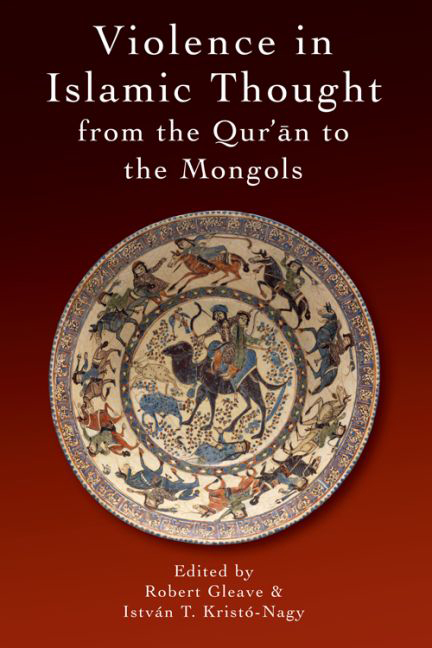Book contents
- Frontmatter
- Contents
- Dates and Abbreviations
- List of Figures and Tables
- 1 INTRODUCTION
- PART I JIHĀD AND CONQUEST: ATTITUDES TO VIOLENCE AGAINST THE EXTERNAL ENEMIES OF THE MUSLIM COMMUNITY
- PART II THE CHALLENGED ESTABLISHMENT: ATTITUDES TO VIOLENCE AGAINST THE STATE AND IN ITS DEFENCE WITHIN THE MUSLIM COMMUNITY
- 6 WHO INSTIGATED VIOLENCE: A REBELLING DEVIL OR A VENGEFUL GOD?
- 7 ATTITUDES TO THE USE OF FIRE IN EXECUTIONS IN LATE ANTIQUITY AND EARLY ISLAM: THE BURNING OF HERETICS AND REBELS IN LATE UMAYYAD IRAQ
- 8 ABBĀSID STATE VIOLENCE AND THE EXECUTION OF IBN ĀISHA
- 9 THE SULTAN AND THE DEFIANT PRINCE IN HUNTING COMPETITION: QUESTIONS OF LEGITIMACY IN HUNTING EPISODES OF ṬABARISTĀN
- PART III LUST AND FLESH: ATTITUDES TO VIOLENCE AGAINST THE DEFENCELESS, INTRA-COMMUNITARIAN VIOLENCE BY NON-STATE ACTORS
- Bibliography
- Index of Qurānic Citations
- General Index
6 - WHO INSTIGATED VIOLENCE: A REBELLING DEVIL OR A VENGEFUL GOD?
from PART II - THE CHALLENGED ESTABLISHMENT: ATTITUDES TO VIOLENCE AGAINST THE STATE AND IN ITS DEFENCE WITHIN THE MUSLIM COMMUNITY
Published online by Cambridge University Press: 15 September 2017
- Frontmatter
- Contents
- Dates and Abbreviations
- List of Figures and Tables
- 1 INTRODUCTION
- PART I JIHĀD AND CONQUEST: ATTITUDES TO VIOLENCE AGAINST THE EXTERNAL ENEMIES OF THE MUSLIM COMMUNITY
- PART II THE CHALLENGED ESTABLISHMENT: ATTITUDES TO VIOLENCE AGAINST THE STATE AND IN ITS DEFENCE WITHIN THE MUSLIM COMMUNITY
- 6 WHO INSTIGATED VIOLENCE: A REBELLING DEVIL OR A VENGEFUL GOD?
- 7 ATTITUDES TO THE USE OF FIRE IN EXECUTIONS IN LATE ANTIQUITY AND EARLY ISLAM: THE BURNING OF HERETICS AND REBELS IN LATE UMAYYAD IRAQ
- 8 ABBĀSID STATE VIOLENCE AND THE EXECUTION OF IBN ĀISHA
- 9 THE SULTAN AND THE DEFIANT PRINCE IN HUNTING COMPETITION: QUESTIONS OF LEGITIMACY IN HUNTING EPISODES OF ṬABARISTĀN
- PART III LUST AND FLESH: ATTITUDES TO VIOLENCE AGAINST THE DEFENCELESS, INTRA-COMMUNITARIAN VIOLENCE BY NON-STATE ACTORS
- Bibliography
- Index of Qurānic Citations
- General Index
Summary
INTRODUCTION
The contrast between the attitude towards violence of the God of the Old Testament and the God of the New Testament was already explored by Marcion (d. c. 160 AD) before the advent of Islam and has been rediscovered again and again since. Marcion saw the former as the creator of the world and God of the law and the latter as the good God, the God of love. The character of the former reflects a community's need for sanctified social norms, while the character of the latter shows the community's and the individual's longing for the hope of salvation. The God of the Qurān is also one of punishment and pardon. This chapter investigates the former aspect and focuses on: (1) the appearance of evil and violence in the universe as described in the Qurān; (2) the philosophical-theological questions revealed by this myth; and (3) its social implications.
VIOLENCE AS REVENGE
One could expect the Qurān to indicate that violence was first committed by the Evil One. In the entire text, however, we do not find any violent act that would belong to the Devil. His crime is not violence, but pride and disobedience. According to the Qurān, the first ever to commit a sin was Iblīs, who refused to obey when Allāh ordered the angels to prostrate themselves in front of Adam. This first sin is the source of all the others. God interrogates Iblīs about the reason that prevented him from executing His order. Iblīs explains that since he was created from fire, he will not bow in front of a creature made of clay such as Adam.
- Type
- Chapter
- Information
- Violence in Islamic Thought from the Qur'an to the Mongols , pp. 93 - 105Publisher: Edinburgh University PressPrint publication year: 2015



